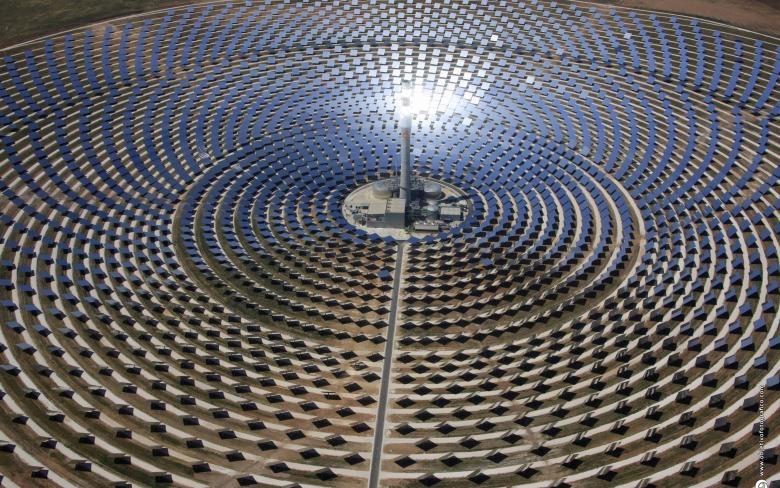
Concentrated Solar Power
Concentrated Solar Power (CSP) is a technology that harnesses the energy of the sun to generate electricity. Unlike photovoltaic (PV) systems, which convert sunlight directly into electricity, CSP uses mirrors or lenses to concentrate sunlight onto a small area.
This concentrated light is then used to heat a fluid, which in turn drives a turbine to produce electricity. CSP is a promising source of renewable energy because it can generate power even when the sun is not shining, using thermal storage systems that store heat for later use.
This makes CSP a reliable and dispatchable source of clean energy that can help reduce greenhouse gas emissions and combat climate change.

Working Principle of Concentrated Solar Power
The working principle of Concentrated Solar Power (CSP) involves the use of mirrors or lenses to concentrate sunlight onto a small area, creating a high temperature at the focal point. This heat is then used to generate electricity through a thermal cycle.
There are different types of CSP systems, but the most common is the parabolic trough system. In this system, long curved mirrors (parabolic troughs) are arranged in rows to track the sun’s movement and concentrate the sunlight onto a tube filled with a heat transfer fluid, usually oil or molten salt. The fluid absorbs the heat and carries it to a heat exchanger, where it is used to generate steam. The steam drives a turbine, which produces electricity.
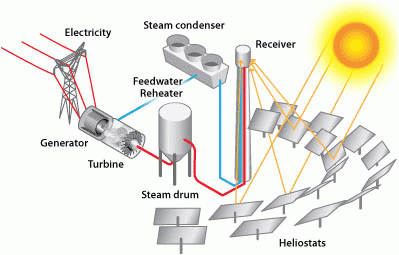
Another type of CSP system is the power tower system. In this system, a large array of flat mirrors (heliostats) are used to focus sunlight onto a central tower. The tower contains a heat exchanger that heats a fluid, which is used to generate steam and drive a turbine to produce electricity.
Both parabolic trough and power tower systems can be equipped with thermal storage systems, which allow them to generate electricity even when the sun is not shining. The heat transfer fluid is stored in tanks, and can be used to produce steam and generate electricity at a later time.
Overall, the working principle of CSP involves the use of concentrated sunlight to produce heat, which is then used to generate electricity through a thermal cycle.
Types of Concentrated Solar Power Systems
There are several types of Concentrated Solar Power (CSP) systems, each with its own unique characteristics and advantages. Here are the most common types:
Parabolic Trough Systems: This is the most common type of CSP system, which uses long curved mirrors (parabolic troughs) to concentrate sunlight onto a tube filled with a heat transfer fluid. The fluid is then used to generate steam and drive a turbine to produce electricity.
Power Tower Systems: In this type of CSP system, a large array of flat mirrors (heliostats) are used to focus sunlight onto a central tower. The tower contains a heat exchanger that heats a fluid, which is then used to generate steam and drive a turbine.
Dish Systems: This type of CSP system uses a large dish-shaped mirror to concentrate sunlight onto a receiver at the focal point. The receiver contains a heat transfer fluid that is used to generate steam and drive a turbine.
Linear Fresnel Systems: Similar to parabolic trough systems, linear Fresnel systems use flat mirrors arranged in rows to concentrate sunlight onto a receiver. However, the mirrors in this system are flat and do not have a parabolic shape.
Hybrid Systems: These systems combine CSP technology with other renewable energy sources, such as wind or photovoltaic (PV) systems, to generate electricity more efficiently.
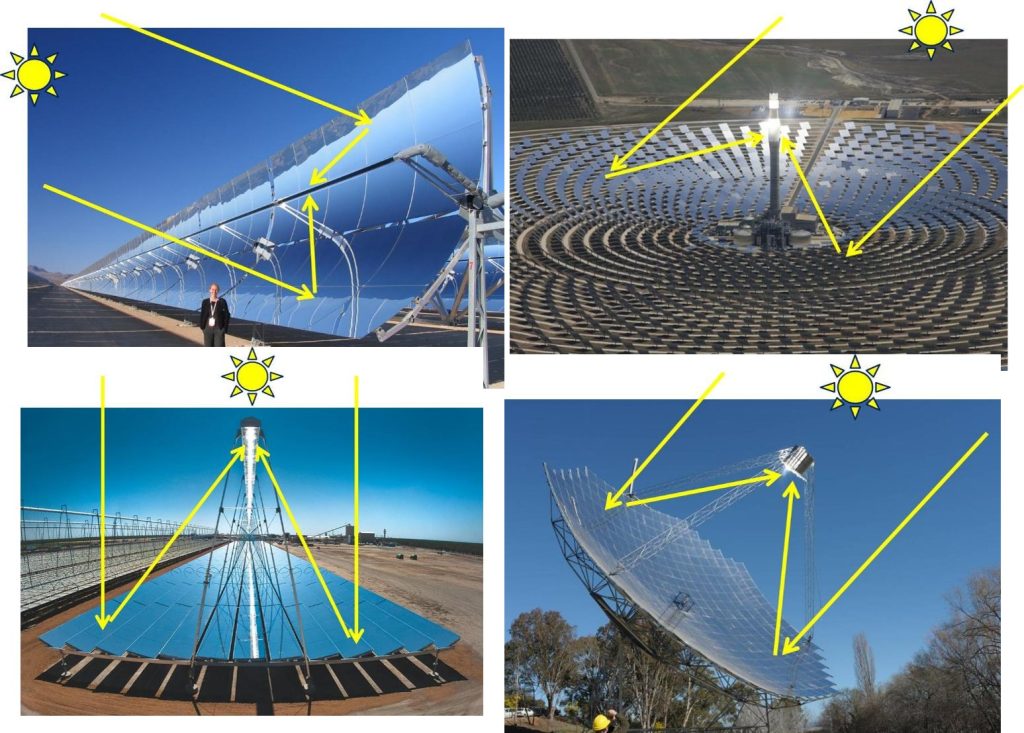
Each type of CSP system has its own advantages and disadvantages, and the choice of system depends on various factors such as location, climate, and cost. However, all CSP systems have the potential to generate reliable and dispatchable clean energy, making them a promising source of renewable energy for the future.
Components of a Concentrated Solar Power Plant
A Concentrated Solar Power (CSP) plant typically consists of several components that work together to harness the energy of the sun and convert it into electricity. Here are the main components of a CSP plant:
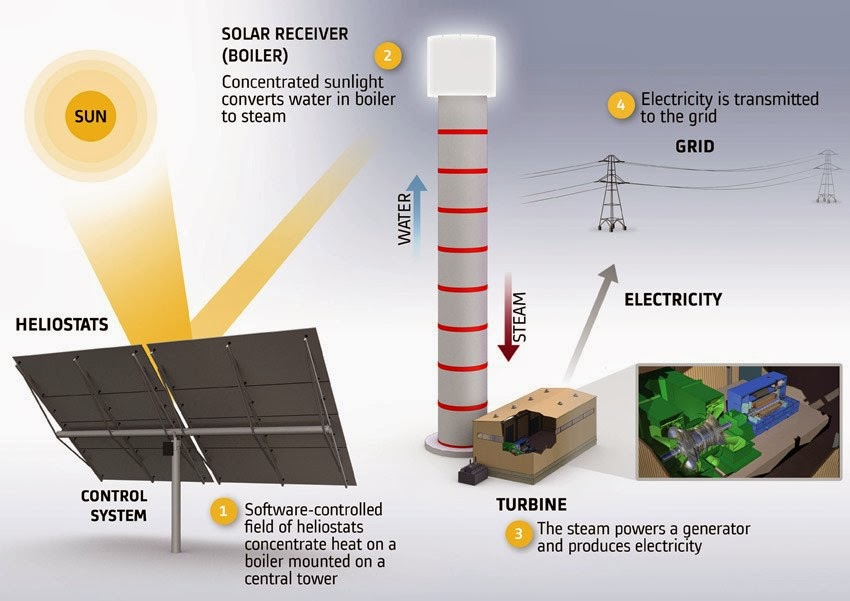
Solar Collectors: These are the mirrors or lenses that concentrate sunlight onto a receiver to generate heat. The type of collector used depends on the type of CSP system.
Receiver: This is the component that absorbs the concentrated sunlight and converts it into heat. The receiver can contain a heat transfer fluid, such as oil or molten salt, or a solid material, such as ceramics or metals.
Heat Transfer System: This system carries the heat from the receiver to a heat exchanger, where it is used to generate steam and drive a turbine.
Thermal Storage System: This system stores excess heat generated during the day so that it can be used to generate electricity at night or during periods of low sunlight. The heat is stored in tanks filled with a heat transfer fluid.
Steam Turbine: This component uses steam generated by the heat transfer system to drive a generator and produce electricity.
Power Block: This is the section of the CSP plant where the steam turbine, generator, and other components that produce electricity are located.
Cooling System: This system cools the steam after it has passed through the turbine so that it can be recycled back to the heat exchanger.
Control and Monitoring System: This system controls the operation of the CSP plant and monitors its performance to ensure that it operates safely and efficiently.
Transmission System: This system transmits the electricity generated by the CSP plant to the grid.
These components work together to create a reliable and dispatchable source of clean energy that can help reduce greenhouse gas emissions and combat climate change.
Advantages of Concentrated Solar Power

Concentrated Solar Power (CSP) has several advantages over other forms of renewable energy and traditional fossil fuel-based energy. Here are some of the key advantages of CSP:
Reliable and Dispatchable: CSP can generate electricity even when the sun is not shining by using thermal storage systems that store heat for later use. This makes CSP a reliable and dispatchable source of clean energy that can help stabilize the grid and support renewable energy integration.
Large-Scale Power Generation: CSP plants can be built on a large scale, with some plants having capacities of hundreds of megawatts. This makes CSP a viable option for meeting the energy needs of large communities or industrial processes.
Reduced Greenhouse Gas Emissions: CSP is a clean energy source that does not emit greenhouse gases or air pollutants during operation. This helps reduce carbon emissions and combat climate change.
Job Creation and Economic Benefits: The construction and operation of CSP plants can create jobs and stimulate economic growth in the surrounding areas. Additionally, CSP technology can be manufactured locally, creating opportunities for local industries and suppliers.
Water Savings: Unlike fossil fuel-based power plants, CSP plants do not require water for electricity generation. This is a significant advantage in water-scarce regions where traditional power plants may face water constraints.
Long Lifespan: CSP plants have a long lifespan, with some components lasting up to 30 years. This makes CSP a long-term and sustainable source of clean energy.
Overall, CSP is a promising source of renewable energy that offers several advantages over traditional fossil fuel-based power generation. As technology continues to improve, CSP has the potential to become even more cost-effective and widespread.
Applications of Concentrated Solar Power
Concentrated Solar Power (CSP) can be used in a variety of applications, including:
Electricity Generation: CSP can be used to generate electricity on a large scale, making it a viable option for meeting the energy needs of communities or industrial processes.
Desalination: CSP can be used to power desalination plants that convert seawater into potable water. This is particularly useful in water-scarce regions where traditional desalination methods may be costly or energy-intensive.
Process Heat: CSP can be used to generate high-temperature heat for industrial processes such as cement or steel production, which require high-temperature heat.
Hybrid Systems: CSP can be combined with other renewable energy sources, such as wind or photovoltaic (PV) systems, to create hybrid systems that generate electricity more efficiently.
Remote Power Supply: CSP can be used to provide electricity to remote areas that are not connected to the grid, such as rural communities or mining operations.
Energy Storage: CSP can be combined with thermal storage systems to store excess energy generated during the day and use it to generate electricity at night or during periods of low sunlight.
Overall, CSP has a wide range of applications that make it a versatile and promising source of renewable energy. As technology continues to improve and costs decrease, CSP is likely to become even more widely used in the coming years.
Future of Concentrated Solar Power
Concentrated Solar Power (CSP) is a form of renewable energy that uses mirrors or lenses to concentrate a large area of sunlight onto a small area, generating heat that is then used to produce electricity. The future of CSP looks promising, as it has several advantages over other renewable energy sources such as wind and solar photovoltaic (PV) systems.
One of the main advantages of CSP is its ability to store energy for use when the sun is not shining. This is typically done using thermal energy storage (TES) systems, which store the heat generated by the concentrated sunlight in materials such as molten salt. This stored heat can then be used to generate electricity even after the sun has set or during cloudy weather. This feature makes CSP an ideal candidate for baseload power, which is power that can be produced continuously and reliably.
Another advantage of CSP is its ability to produce heat at high temperatures, which can be used to generate high-pressure steam and drive turbines to produce electricity. This makes CSP suitable for industrial applications that require high-temperature heat, such as chemical production, desalination, and oil refining.
In terms of the future of CSP, the technology is expected to continue to improve and become more efficient. One area of improvement is the use of advanced materials and coatings for the mirrors and receivers, which can improve their performance and reduce costs. Another area of improvement is the use of advanced control systems and predictive analytics to optimize the performance of CSP plants.
CSP is also expected to become more competitive with other renewable energy sources such as wind and solar PV. As the cost of energy storage continues to decrease, CSP’s ability to store energy will become increasingly valuable. In addition, CSP’s ability to produce high-temperature heat for industrial applications may make it a more attractive option for certain types of customers.
Overall, the future of CSP looks bright, and the technology is likely to play an increasingly important role in the transition to a more sustainable energy future.
Comparison with Other Renewable Energy Sources
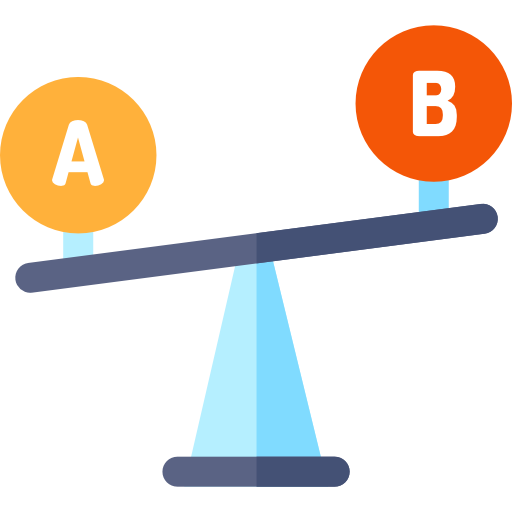
Compared to other renewable energy sources such as wind and solar photovoltaic (PV) systems, Concentrated Solar Power (CSP) has several unique advantages and disadvantages.
One advantage of CSP is its ability to store energy for use when the sun is not shining. This is typically done using thermal energy storage (TES) systems, which store the heat generated by the concentrated sunlight in materials such as molten salt. This stored energy can then be used to generate electricity even after the sun has set or during cloudy weather, making CSP an ideal candidate for baseload power. In contrast, wind and solar PV systems produce energy only when the wind is blowing or the sun is shining, respectively, and cannot store energy as efficiently as CSP.
Another advantage of CSP is its ability to produce high-temperature heat, which can be used for a variety of industrial applications. This makes CSP a more versatile source of renewable energy compared to wind and solar PV systems, which are primarily used for electricity generation.
However, CSP also has some disadvantages compared to wind and solar PV systems. One major disadvantage is its high capital cost, which makes it less attractive for small-scale projects or applications. In addition, CSP requires a large amount of land area to achieve high levels of energy production, which can be a limiting factor in some regions.
Another disadvantage of CSP is its reliance on direct sunlight, which means that its performance can be affected by weather conditions such as cloud cover and dust. In contrast, wind and solar PV systems can produce energy even in partially cloudy conditions.
Overall, each renewable energy source has its unique advantages and disadvantages, and the choice of which to use depends on factors such as location, available resources, and the specific energy needs of the application.
Conclusion: Prospects of Concentrated Solar Power.
In conclusion, Concentrated Solar Power (CSP) has several advantages over other renewable energy sources, including its ability to store energy for use when the sun is not shining and its ability to produce high-temperature heat for industrial applications. As the technology continues to improve and become more efficient, CSP is expected to become more competitive with other renewable energy sources and play an increasingly important role in the transition to a more sustainable energy future. With ongoing advancements in materials, coatings, control systems, and energy storage, the prospects of CSP are very promising, and it has the potential to be a key player in the global effort to reduce greenhouse gas emissions and combat climate change.
